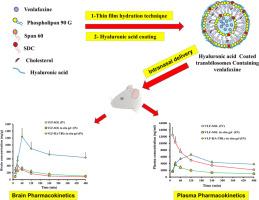Brain targeting of venlafaxine via intranasal transbilosomes thermogel for improved management of depressive disorder
IF 3.7
3区 医学
Q2 CHEMISTRY, MEDICINAL
引用次数: 0
Abstract
The current research aimed to design and optimize hyaluronic acid-coated transbilosomes containing venlafaxine (VLF-HA-TBLs) for nose-to-brain delivery for improved management of depressive disorder. Venlafaxine-loaded transbilosomes (VLF-TBLs) were developed according to the film hydration procedure, optimized for maximum efficiency using the quality by design-based Box-Behnken design (BBD), and then coated with hyaluronic acid (HA). The optimized VLF-HA-TBLs were subjected to in vitro characterization, integrated into a thermolabile gel, and then exposed to in vivo evaluation studies. The results revealed that the VLF-HA-TBLs formulation exhibited acceptable size (185.6 ± 4.9 nm), surface charge (-39.8 ± 1.7 mV), and entrapment efficiency (69.6 ± 2.6 %). The morphological study revealed that nanovesicles were spherical and displayed a consistent size distribution without particle aggregation. It also showed improved ex vivo nasal diffusion and a prolonged release profile. In addition, the formulated VLF-HA-TBLs were stable under the studied conditions and tolerable when applied intranasally. Compared to the intranasal administration of VLF solution (VLF-SOL), the biodistribution analysis showed that VLF-HA-TBLs delivered intranasally had a relative bioavailability of 441 % in the brain and 288 % in plasma. Moreover, the intranasal delivery of VLF-HA-TBLs demonstrated much higher bioavailability (512 %) in the brain compared to VLF-SOL administered intravenously. Collectively, it could be possible to infer that HA-TBLs might be an effective nanocarrier to administer VLF to the brain via the nasal route.

通过鼻内透纤体热凝胶实现文拉法辛的脑靶向治疗,从而改善抑郁症的治疗。
目前的研究旨在设计和优化含有文拉法辛的透明质酸涂层经纤体(VLF-HA-TBLs),用于鼻脑给药,改善抑郁症的治疗。根据薄膜水合过程开发出了文拉法辛负载型反式螺旋体(VLF-TBLs),并利用基于设计的盒-贝肯设计(BBD)方法对其进行了优化,以实现最高效率,然后在其表面涂上透明质酸(HA)。对优化后的 VLF-HA-TBLs 进行了体外表征,将其整合到热稳定凝胶中,然后进行了体内评估研究。结果表明,VLF-HA-TBLs 制剂具有可接受的尺寸(185.6±4.9 nm)、表面电荷(-39.8±1.7 mV)和夹持效率(69.6±2.6%)。形态学研究显示,纳米微粒呈球形,大小分布一致,无颗粒聚集。它还显示出较好的体内鼻腔扩散性和较长的释放曲线。此外,配制的 VLF-HA-TBLs 在研究条件下是稳定的,鼻内使用时也是可耐受的。与VLF溶液(VLF-SOL)鼻内给药相比,生物分布分析表明,VLF-HA-TBLs鼻内给药在大脑中的相对生物利用率为441%,在血浆中的生物利用率为288%。此外,与静脉注射 VLF-SOL 相比,鼻内给药的 VLF-HA-TBLs 在大脑中的生物利用率要高得多(512%)。综上所述,可以推断HA-TBLs可能是一种有效的纳米载体,可通过鼻腔途径将VLF注入大脑。
本文章由计算机程序翻译,如有差异,请以英文原文为准。
求助全文
约1分钟内获得全文
求助全文
来源期刊
CiteScore
7.30
自引率
13.20%
发文量
367
审稿时长
33 days
期刊介绍:
The Journal of Pharmaceutical Sciences will publish original research papers, original research notes, invited topical reviews (including Minireviews), and editorial commentary and news. The area of focus shall be concepts in basic pharmaceutical science and such topics as chemical processing of pharmaceuticals, including crystallization, lyophilization, chemical stability of drugs, pharmacokinetics, biopharmaceutics, pharmacodynamics, pro-drug developments, metabolic disposition of bioactive agents, dosage form design, protein-peptide chemistry and biotechnology specifically as these relate to pharmaceutical technology, and targeted drug delivery.

 求助内容:
求助内容: 应助结果提醒方式:
应助结果提醒方式:


